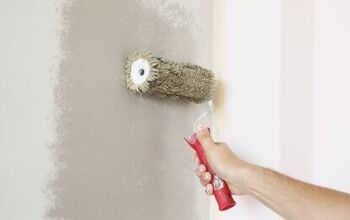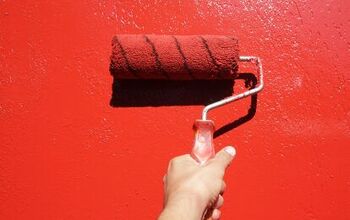What Is The Best Paint To Hide Imperfections? (Find Out Now!)

Painting your home is an ordeal that can often end up with minor imperfections. A scuff here, a stain there…It happens with the best of us. Unfortunately, those minor nicks and cuts can make an otherwise flawless home look terrible. Of course, this can be a major issue. Getting a good coat of paint can hide imperfections, but which is best for that?
When choosing a paint finish, the best choice for hiding imperfections is a flat finish such as matte, eggshell, or satin. If you want to hide imperfections through the use of color, then it’s better to stick to darker colors like grey, tan, or terra cotta. Adding a textured finish can also help.
If you want to get a flawless look to your walls, it’s important to know how your paint can play a role in it. Take it from my clumsy behind. You’re going to like the way your walls look.
Do You Need to Hire a Paint Contractor?
Get free, zero-commitment quotes from pro contractors near you.

How Does Paint Hide Imperfections?
Paint technically doesn’t hide imperfections. It can either cover them up or decrease their visibility, based on the features that you choose to get. Hiding imperfections in your walls is all about choosing the right traits for your paint. Let’s take a look at the best tips for your painting perfection.
Paint Finish
We’re going to start out this article by pointing out that paint finish is going to be the number one thing that changes how your home looks. This is especially true if you have imperfections like a dent in the wall or a scratch from moving furniture.
The first thing you need to be aware of is the finish of your paint. Glossy paints are way more reflective, which means that you will end up seeing all the dings and dents the moment that the light reflects off of it. If you want to get a flawless look, you need a finish that isn’t glossy. These are often the best options:
- Eggshell
- Satin
- Matte
Author’s Note: Matte and eggshell walls can be very difficult to clean and very easy to stain. If you have to have a flat finish, avoid matte since it’s the hardest one to clean. Satin tends to be the best. If you can, try to opt for an outdoor use flat finish paint since it’s easier to clean and more durable.
Paint Color
Paint colors can also have a somewhat unusual ability to accentuate or downplay flaws. With that said, there seems to be a little bit of a debate on what works here. Here’s a quick note on what works and what doesn’t:
- Most people agree that darker matte colors tend to swallow up light, making them better for interior walls. This tends to make them good if you want to make sure that you can’t see dents and dings. However, if you scratch or break the wall, cracks are going to be more visible.
- Lighter colors are better for areas around windows. This is a good way to help open up a room. Since white and colors similar to it tend to help let light in, it’ll make your room look breezy. The light will be in close enough proximity to the light paint to also fill in gaps.
- Avoid darker colors around windows or as trim accents. We all know how easy it is to “misfire” with a paint brush near textured areas of trim. Dark colors make it way easier to spot.
Primer?
Yes, you should always use a primer when you want to paint something. This is actually considered to be the first step on getting that flawless finish you want. How you prime your stuff all depends on your personal preferences. Many painters swear on having a separate primer coat for their homes simply because they claim it makes the surface smoother.
However, the evidence on whether you need a separate coat of primer is totally anecdotal. If you want to get a similar look, you can use paint that has primer premixed into it.
Texture Topping
You know how some people tend to add sand or other texture-enhancing additives to their paint? You might want to consider it. Believe it or not, this is a good way to cover up imperfections. Texture can help cover up minor scrapes and can also reduce the chances of people noticing staining or dust buildup.
Can All Imperfections Be Hidden?
Here’s the hard truth about imperfections: not all of them will be easy to hide. Even if you get the right paint, you are going to have some types of imperfections that just don’t work well with hiding. There are limitations to what you can hide, especially when it comes to stains and moments where you get scratches on the paint.
If you are very concerned about having imperfections show up on your paint, the best thing that you can do is hire a painter. Otherwise, you can use these tips below to try to make sure that everything looks its best:
- Prep and prime your surface before you paint. This includes repairing any dings you see with plaster and primer. If you want to get a good finish, you have to make sure that the foundation of your paint job is good to go. Once you have repaired everything, smoothed things out, and also primed it, you’ll be able to do better with your painting.
- Oh, and clean your surface before you hit the paint. You might’ve forgotten that cleaning the area is a part of prepping it, right? Well, consider this your sign from the universe to ensure that you’ve cleaned it. Trisodium phosphate is a good choice here.
- Choose a finish that works with your area. I’m going to point this out: matte paint on metal looks terrible on cars or on things that are supposed to be shiny. Sometimes, the paint is the imperfection.
- Always use painter’s tape. Trust me when I say that there are a lot of people out there who think that painter’s tape and trying to “eyeball” things is okay. It’s not. Even if you can do precision work by hand, it’s a bad idea to do so. Painter’s tape is there to help prevent problems sparked by spills and other mishaps.
Technique Tips That Reduce Imperfections
Once you prep your area, it’s a good idea to know what you can do to avoid other messes to occur. Once again, it’s best to let a pro do this if you can afford it.
- Use a roller brush and apply multiple thin coats. Thicker coats are more likely to streak or otherwise drip. Flat brushes are also more likely to streak. This can cause the imperfections that can be much harder to deal with once dry.
- Always use the technique that’s right for the paint. Some paints require you to buffer and brush away grit before you get the paint on. Others won’t. Read the directions before you worry about this.
- Fill in small holes in your wall with a tiny tipped paintbrush. This will help alleviate the problem of hearing “you missed a spot.” It also can help patch up tiny holes caused by pinholes. This is a common issue that you might have if you live in an apartment. If you wanna avoid holes altogether, use sticky tack to post your posters.
- Remember that you can always hide an imperfection by adding a painting or a stick-on border in the area. It’s not ideal, sure, but it’s a surefire way to make it work. After all, people are not going to be able to see a smudge or mistake if it’s covered up by a poster.
Do You Need to Hire a Paint Contractor?
Get free, zero-commitment quotes from pro contractors near you.

Related Questions
What is the worst type of paint for hiding imperfections?
If we had to pick on type of paint for hiding imperfections, it would have to be a bright, highly-reflective high gloss paint. Something along the lines of having a high gloss sprayable paint, similar to the “candy paint” used in cars, would probably fit that bill.This is partly one of the most commonly-cited reasons why people are advised not to try to paint their own cars or retro appliances. It’s really easy to botch.
Should you paint your trim lighter or darker than your walls?
Window trim that is painted darker than the walls will have a “frame” effect. This is great if you like the idea of picture frames, but most people tend to find it jarring with typical window sizes. Most of the time, the best course of action is to paint your window trim and side trim lighter than your wall color. Or, just paint it the same color for a uniform look.
Can you paint over a painting mistake?
In most cases, you can fix paint that ended up in the wrong area through the use of paint thinner, painter’s tape, and a light, quick coat of paint over the offending area. If the shades of paint are fairly similar to one another, you also can try to paint over it with one to two coats of the proper color. It’s best to use personal discretion here.
Related Guides

Ossiana Tepfenhart is an expert writer, focusing on interior design and general home tips. Writing is her life, and it's what she does best. Her interests include art and real estate investments.
More by Ossiana Tepfenhart



























